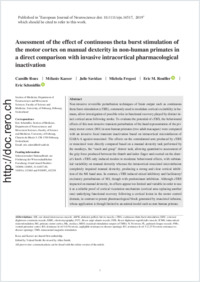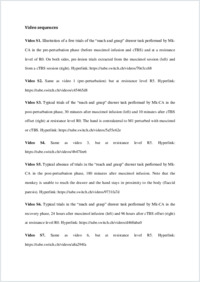Assessment of the effect of continuous theta burst stimulation of the motor cortex on manual dexterity in non-human primates in a direct comparison with invasive intracortical pharmacological inactivation
- Roux, Camille Section of Medicine, Department of Neurosciences and Movement Sciences, Faculty of Science and Medicine, University of Fribourg, Switzerland
- Kaeser, Mélanie Section of Medicine, Department of Neurosciences and Movement Sciences, Faculty of Science and Medicine, University of Fribourg, Switzerland
- Savidan, Julie Section of Medicine, Department of Neurosciences and Movement Sciences, Faculty of Science and Medicine, University of Fribourg, Switzerland
- Fregosi, Michela Section of Medicine, Department of Neurosciences and Movement Sciences, Faculty of Science and Medicine, University of Fribourg, Switzerland
- Rouiller, Eric M. Section of Medicine, Department of Neurosciences and Movement Sciences, Faculty of Science and Medicine, University of Fribourg, Switzerland
- Schmidlin, Eric Section of Medicine, Department of Neurosciences and Movement Sciences, Faculty of Science and Medicine, University of Fribourg, Switzerland
-
2019
Published in:
- European Journal of Neuroscience. - 2019, vol. 50, no. 10, p. 3599-3613
English
Non-invasive reversible perturbation techniques of brain output such as continuous theta burst stimulation (cTBS), commonly used to modulate cortical excitability in humans, allow investigation of possible roles in functional recovery played by distinct intact cortical areas following stroke. To evaluate the potential of cTBS, the behavioural effects of this non-invasive transient perturbation of the hand representation of the primary motor cortex (M1) in non-human primates (two adult macaques) were compared with an invasive focal transient inactivation based on intracortical microinfusion of GABA-A agonist muscimol. The effects on the contralateral arm produced by cTBS or muscimol were directly compared based on a manual dexterity task performed by the monkeys, the “reach and grasp” drawer task, allowing quantitative assessment of the grip force produced between the thumb and index finger and exerted on the drawer's knob. cTBS only induced modest to moderate behavioural effects, with substantial variability on manual dexterity whereas the intracortical muscimol microinfusion completely impaired manual dexterity, producing a strong and clear cortical inhibition of the M1 hand area. In contrast, cTBS induced mixed inhibitory and facilitatory/excitatory perturbations of M1, though with predominant inhibition. Although cTBS impacted on manual dexterity, its effects appear too limited and variable in order to use it as a reliable proof of cortical vicariation mechanism (cortical area replacing another one) underlying functional recovery following a cortical lesion in the motor control domain, in contrast to potent pharmacological block generated by muscimol infusion, whose application is though limited to an animal model such as non-human primate.
- Faculty
- Faculté des sciences et de médecine
- Department
- Département de Médecine
- Language
-
- English
- Classification
- Biological sciences
- License
- License undefined
- Identifiers
-
- RERO DOC 327441
- DOI 10.1111/ejn.14517
- Persistent URL
- https://folia.unifr.ch/unifr/documents/308275
Other files
Statistics
Document views: 64
File downloads:
- rou_aec.pdf: 149
- rou_aec_sm.pdf: 78

